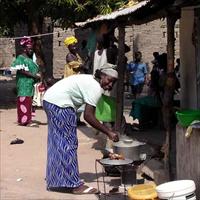GLOBAL: High food prices put pressure on HIV programmes

Steadily increasing prices could lead to a lack of affordable and nourishing food, endangering the lives of people living with HIV in the developing world, experts have said.
"As prices continue to rise, people will start to buy cheaper, less nutritious food and may begin to skip meals – in Lesotho we are already seeing people skipping meals because they can't afford food," Alan Whiteside, an economist with South Africa's University of KwaZulu-Natal, told a press conference at the International AIDS Conference in Mexico on Thursday.
"For people living with HIV, who require more nutrition than healthy people, this will have terrible consequences."
Rising oil prices, the impact of climate change and the loss of agricultural land to biofuel production have all contributed to the current crisis affecting people in the developing world, most of whom rely on agriculture for their livelihood.
"The effects of climate change have made food production less secure, droughts longer, and when the rains come they are heavier and damage crops," Whiteside explained.
He noted that HIV-positive people on antiretroviral (ARV) medication, who skipped doses because they did not have food to take with their medication, risked developing drug resistance, which could lead to treatment failure.
A likely increase in mobility as people leave their homes to search for food and an income also had the potential to disrupt treatment, said Martin Bloem, head of HIV/AIDS and nutrition at the United Nations World Food Programme (WFP). Increased mobility has been associated with increased HIV risk, as men and women leave their marital home for long periods.
Food shortages may also lead to women and girls resorting to transactional sex, another factor that increases the risk of HIV infection.
A way out of poverty
Robin Jackson, a UNAIDS special advisor on food and nutrition, said providing daily food packages containing corn soy blend, maize-meal, beans and sugar was relatively inexpensive: about US$0.70 for an adult and $0.31 for a child.
But a combination of high food prices and funding shortfalls meant the WFP had been forced to reduce the number of people it was supporting around the world at a time when the need was increasing. "In the past, only the poorest 10 percent of the population has generally needed assistance, but that figure is rising along with food prices," Bloem said.
Several speakers noted that donors had not done enough to incorporate food support into their HIV programmes. "Putting people on treatment without ensuring that they have enough to eat is like sending your kids to school without any books," said Jackson. "With high food prices here to stay for the foreseeable future, it is critical to supplement HIV and TB programmes with a nutritional component."
Besides food aid, speakers also called for more programmes to provide livelihood support for agricultural production in the form of direct cash transfers or micro-financing.
"In some cases, such as school feeding and feeding people on ARVs, provision of food packages is the ideal solution," Whiteside said. "But where local markets are able to provide a nutritious diet, cash transfers may be the best way forward."
Supporting families engaged in agriculture has the dual benefit of increasing food production and raising nutrition and income levels.
A cash transfer scheme for poor families in Mexico, started by the International Food Policy Research Institute, has brought a 15 percent increase in the number of girls attending secondary school and a 12 percent drop in illnesses among children under five.
 Back and Next - Back and Next
Back and Next - Back and Next See Also - See Also
See Also - See Also